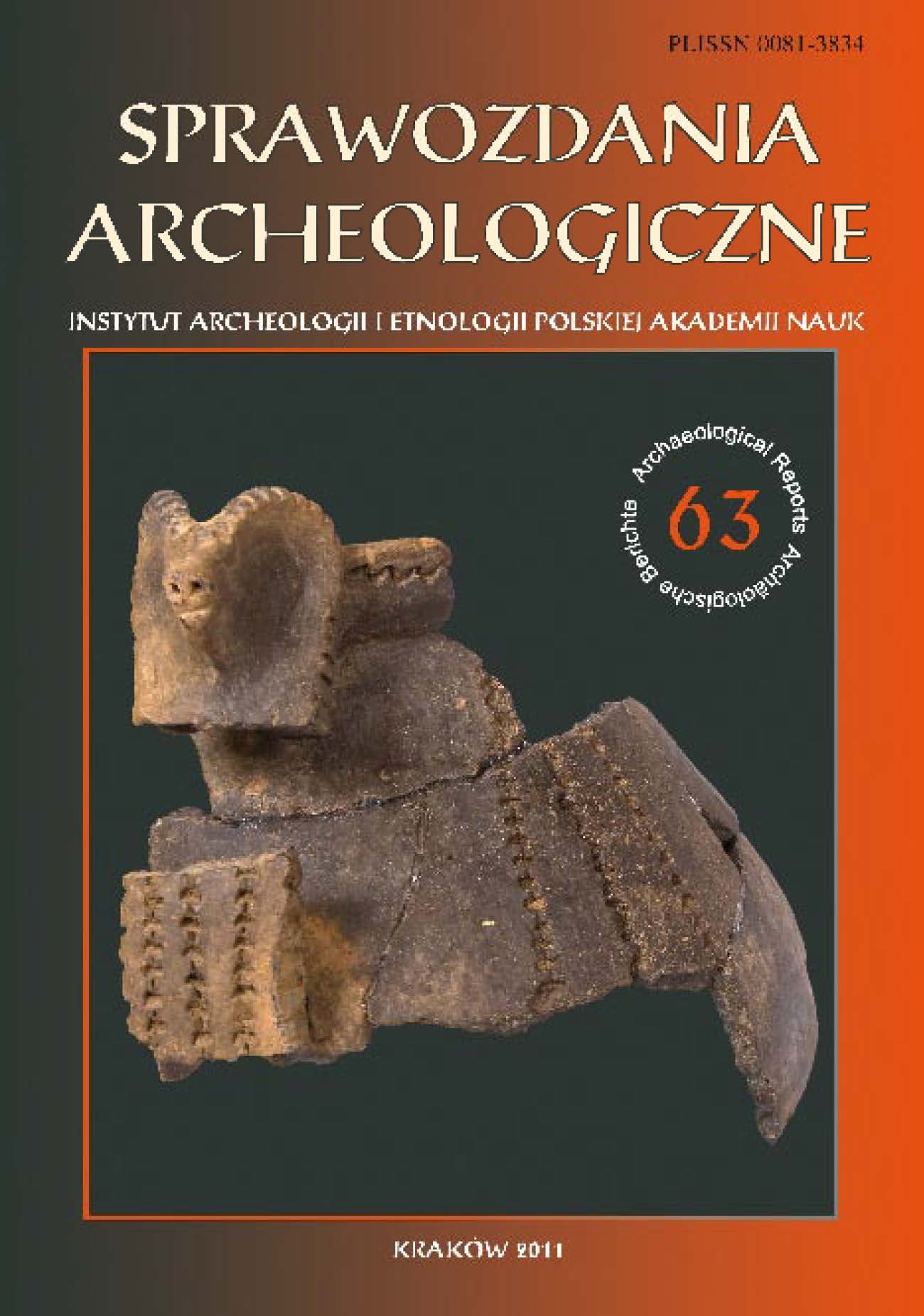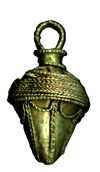Cultural Relations between the Great Hungarian Plain and the Southern Baltic Coast. Imports from the Bodrogkeresztúr Culture on the Site Dąbki 9 (Middle Pomerania) = Relacje kulturowe między terenami Wielkiej Niziny Węgierskiej a południowym wybrzeżem Bał
Keywords:
Pomerania, Neolithic, imports, Bodrogkeresztúr culture, Funnel Beaker CultureAbstract
Around 5600–5500 calBC first farmers appeared at the North European Lowland initiating ca 2.000 years lasting process of neolithisation of this area. A unique feature of Dąbki settlement is the presence of several horizons of imports in the Late Mesolithic and early FBC context, mainly pottery vessels. These imports point toward an important role of that place in the exchange system between Mesolithic groups inhabited Central European Lowland and Neolithic people. Beside local hunters-gatherers, groups of Linear Band Pottery, Stroke Band Pottery, Ertebølle, Brześć Kujawski Group, Funnel Beaker and finally Bodrogkeresztúr cultures were engaged in these contacts. Till 2009 on site 9 at Dąbki there were discovered 8 potsherds of the Bodrogkeresztúr culture. Ornamentation, morphology, and technology of the fragments are typical for the pottery of the culture in question. We can synchronize the discussed imports with the earliest Funnel Beaker settlement stage in Dąbki, i.e. with years 4100/4000 cal BC
Downloads
References
Balcer B. 1986. Zagadnienie neolityzacji ziem Polski w świetle badań przemysłów krzemiennych związanych z kulturami ceramicznymi. Archeologia Polski 31(1), 95-124
Benecke N. 1999. The project “The Holocene History of the European Vertebrate Fauna”. In N. Benecke (ed.), The Holocene History of the European Vertebrate Fauna. Modern Aspects of Research (= Archäologie in Eurasien 6). Rahden/Westf., 151-161
Bognár-Kutzián I. 1963. The Copper Age cemetery of Tiszapolgár-Basatanya. Budapest
Csányi M., Raczky P. and Tárnoki J. 2009. Előzetes jelentés a rézkori bodrogkeresztúri kultúra Rákóczifalva-Bagi-földön feltárt temetőjéről [Preliminary report of the cemetery of the Bodrogkeresztúr culture excavated at Rákóczifalva-Bagi-föld]. Tisicum 17, 13-34
Czekaj-Zastawny A., Kabaciński J. and Terberger T. 2011. Long distance exchange in the Central European Neolithic: Hungary to the Baltic. Antiquity 85(327), 43-58
Czekaj-Zastawny A., Kabaciński J. and Terberger T. in press. Relacje łowiecko-zbierackich społeczności z Dąbek z kulturami neolitycznymi Europy środkowej
Czerniak L. 1980. Rozwój społeczeństw kultury późnej ceramiki wstęgowej na Kujawach. Poznań
Czerniak L. 1994. Wczesny i środkowy okres neolitu na Kujawach, 5400-3650 p.n.e. Poznań
Hartz S. and Lübke H. 2004. Zur chronostratigraphischen Gliederung der Ertebølle Kultur und frühesten Trichterbecherkultur in der südlichen Mecklenburger Bucht. Jahrbuch Bodendenkmalpflege Mecklenburg-Vorpommern 52, 119-143
Ilkiewicz J. 1989. From Studies on Cultures of the 4th Millennium B.C. in the Central Part of the Polish Coastal Area. Przegląd Archeologiczny 36, 17-55
Ilkiewicz J. 1997. From Studies on Ertebřlle Type Cultures in the Koszalinian Coastal area (Dąbki 9, Koszalin - Dzierżęcino 7). In D. Król (ed.), The Built Environment of Coast Areas during the Stone Age. Gdańsk, 50-65
Fischer A. 2002. Food for feasting? An evaluation of explanations of the Neolithisation of Denmark and southern Sweden. In A. Fischer and K. Kristiansen (ed.), The Neolithisation of Denmark - 150 years of debate. Sheffield, 343-93
Kabaciński J. 2001. The Mesolithic-Neolithic transition in the southern Baltic coastlands. Fontes Archaeologici Posnanienses 39, 129-161
Kabaciński J., Heinrich D. and Terberger T. 2009. Dąbki revisited - new evidence on the question of earliest cattle use in Pomerania. In S. McCartan, R. Schulting, G. Warren and P. Woodman (eds.), Mesolithic Horizons. Oxford 548-555
Kabaciński J. and Terberger T. 2009. From Late Hunter-fishers to Early Farmers on the Pomeranian Coast. New research at Dąbki 9, Koszalin District. In J. M. Burdukiewicz, K. Cyrek, P. Dyczek and K. Szymczak (eds.), Understanding the Past. Papers offered to Stefan K. Kozłowski. Warszawa, 165-184
Kaczanowska M. 1980. Uwagi o surowcach, technice i typologii przemysłu krzemiennego kultury bodrogkereszturskiej i grupy Lažňany. Acta Archaeologica Carpathica 20, 19 - 56
Kaczanowska M. 1986. Materiały typu „Scheibenhenkel” w Krakowie - Nowej Hucie-Mogile (stan. 55). Materiały Archeologiczne Nowej Huty 10, 43-47
Kaczanowska M. 2009. Obrządek pogrzebowy kultury lendzielskiej. In A. Czekaj-Zastawny (ed.), Obrządek pogrzebowy kultur pochodzenia naddunajskiego w neolicie Polski południowowschodniej (5600-5500 - 2900 BC) [The Funerary Rite of the Danubian Cultures in the Neolithic of Southeastern Poland (5600–5500 - 2900 BC)]. Kraków, 67-105
Kaczanowska M. and Kozłowski J. K. 2005. Europa w dobie neolitu. In J. Śliwa (ed.), Stary i Nowy Świat. Od „rewolucji” neolitycznej do podbojów Aleksandra Wielkiego (= Wielka historia świata 2). Kraków, 97-186
Kadrow S. 1989. Materiały kultury lubelsko-wołyńskiej ze stanowiska nr 1 D w Strzyżowie woj. zamojskie, z badań 1961-1963 r. Prace i Materiały Zamojskie. Archeologia 2, 5-33
Kadrow S. 1992. Badania sondażowe na osadzie kultury ceramiki wstęgowej rytej na stanowisku nr 38 w Albigowej, woj. Rzeszów. Materiały i Sprawozdania Rzeszowskiego Ośrodka Archeologicznego za lata 1985-1990, 131-139
Kadrow S. 1992. Osada kultury lubelsko-wołyńskiej na stan. 35 w Kosinie, gm. loco, woj. Rzeszów. Materiały i Sprawozdania Rzeszowskiego Ośrodka Archeologicznego za lata 1985-1990, 141-150
Kadrow S. and Zakościelna A. 2000. An Outline of the Evolution of Danubian Cultures in Małopolska and Western Ukraine. Baltic-Pontic Studies 9, 187-255
Kalicz N. 1995. Letenye-Szentkeresztdomb: ein Siedlungsplatz der Balaton-Lasinja-Kultur. In T. Kovács (ed.), Neuere Daten zur Siedlungsgeschichte und Chronologie der Kupferrzeit des Karpatenbeckens (= Inventaria Praehistorica Hungariae 7). Budapest, 61-106
Kamieńska J. and Kozłowski J. K. 1970. The Lengyel and Tisza Cultures. In T. Wiślański (ed.), The Neolithic in Poland. Wrocław, 76-143
Kamieńska J. and Kozłowski J. K. 1990. Entwicklung und Gliederung der Lengyel- und Polgar- Kulturgruppen in Polen (= Zeszyty Naukowe Uniwersytetu Jagiellońskiego 925, Prace Archeologiczne). Kraków
Klassen L. 2004. Jade und Kupfer: Untersuchungen zum Neolithisierungsprozess im westlichen Ostseeraum unter besonderer Ber¨ucksichtigung der Kulturentwicklung Europas 5500-3500 BC (= Jutland Archaeological Society publications 47). Aarhus
Koch Nielsen E. 1987. Ertebřlle and Funnel Beaker pots as tools. On Traces of Production Techniques and Use. Acta Archaeologica 57, 107-120
Kozłowski J. K. 1968. Materiały neolityczne i eneolityczne odkryte na stanowisku Nowa Huta - Wyciąże I (badania w latach 1950-1952). Materiały Archeologiczne Nowej Huty 1, 13-90
Kozłowski J. K. 1971. Eneolityczne groby szkieletowe z Nowej Huty Wyciąża, pow. Kraków. Materiały Starożytne i wczesnośredniowieczne 1, 65-98
Kozłowski J. K. 1989. Grupy kulturowe z lendzielską ceramiką niemalowaną i jednostki powstałe na podłożu wpływów późnopolgarskich. In J. Kmieciński (ed.), Pradzieje ziem polskich I(1). Warszawa-Łódź, 156-202
Kozłowski J. K. 2006. Grupa Wyciąże-Złotniki i bezpośrednie oddziaływania późnopolgarskie [The Wyciąże-Złotniki Group and direct Late-Polgar influence]. In M. Kaczanowska (ed.), Dziedzictwo cywilizacji naddunajskich: Małopolska na przełomie epoki kamienia i miedzi. Kraków, 53-61
Lech J. 1989. O rewolucji neolitycznej i krzemieniarstwie. Część II. Wokół neolityzacji dorzeczy Wisły i Odry. Archeologia Polski 34 (1), 55-125
Łęczycki S. 2005. Massive Kupferartefakte aus dem Äneolithikum im Gebiet des heutigen Mittelschlesiens [Masywne eneolityczne artefakty miedziane na Śląsku Środkowym]. Sprawozdania Archeologiczne 57, 53-86
Makkay J. (ed.). 1989, Békés Megye Régészeti Topográfiája 2. Budapest
Niesiołowska-Śreniowska E. 1973. The Problem of Mesolithic Traditions in the Neolithic Cultures of Poland. In S. K. Kozłowski (ed.), The Mesolithic in Europe. Warszawa, 441-451
Novotný B. 1958. Slovensko v mladšej dobe kamiennej. Bratislava
Nowak M. 2009. Drugi etap neolityzacji ziem polskich. Kraków
Patay P. 1963. Bodrogkeresztúr-Dudince-Ludanice. Musaica 3, 11-21
Patay P. 1975. Die hochkupferzeitliche Bodrogkeresztúr-Kultur. Bericht der Romisch-Germanischen Kommission 55, 1-71
Patay P. 1978. Das Kupferzeitliche Gräberfeld von Tiszavalk-Kenderföld (= Fontes Archaeologici Hungariae). Budapest
Patay P. 1984. Kupferzeitliche Meißel, Beile und Äxte in Ungarn (= Prähistorische Bronzefunde IX/15). München
Patay P. 2005. Kupferzeitliche Siedlung von Tiszalúc (= Inventaria Praehistorica Hungariae 11). Budapest
Patay P. 2008. A Bodrogkeresztúri kultúra belsö idörendjéröl. Archaeologiai Értesítö 133, 21-48
Patay R. 2002. Settlement remains of the Bodrogkeresztúr culture at Mezözombor. Antaeus 25, 355-375
Raczky P. 1991. New Data on the Southern Connections and Relative Chronology of the „Bodrogkeresztúr - Hunyadi halom” Complex. In J. Lichardus (ed.), Die Kupferzeit als historische Epoche. Bonn, 329-245
Raczky P. 1995. New data on the absolute chronology of the Copper Age in the Carpathian Basin. In T. Kovács (ed.), Neuere Daten zur Siedlungsgeschichte und Chronologie der Kupferrzeit des Karpatenbeckens (= Inventaria Praehistorica Hungariae 7). Budapest, 51-60
Rook E. 1980. Osadnictwo neolityczne w jaskiniach Wyżyny Krakowsko-Częstochowskiej. Materiały Archeologiczne 20, 5-130
Rook E. 1995. Wykorzystywanie jaskiń (in: Młodsza epoka kamienia). In Pradzieje i średniowiecze (= Natura i kultura w krajobrazie Jury). Kraków, 62-69
Sobkowiak I. 2009. Wytwórczość krzemienna społeczności typu Ertebølle ze stanowiska nr 9 w Dąbkach. Poznań, typescript
Stadler P. 1999. Ein Beitrag zur Absolutchronologie des Neolithikums in Ostösterreich aufgrund der 14C-Daten. In E. Lenneis, Ch. Neugebauer-Maresch and E. Ruttkay (eds.), Jungsteinzeit im Osten Österreichs. St. Pölten-Wien, 210-224
Šiška S. 1972. Gräberfelder der Lažňany-Gruppe in der Slowakei. Slovenská Archeológia 20/1, 107-175
Šiška S. 1973. Die Lažňany-Kulturgruppe in der Ostslowakei. In B. Chropovský (ed.), Symposium über die Entstehung und Chronologie der Badener Kultur. Bratislava, 453-464
Terberger T., Hartz S. and Kabaciński J. 2009. Late hunter-gatherer and early farmer contacts in the southern Baltic - a discussion. In H. Glřrstad, H. and C. Prescott (eds.), Neolithisation as if history mattered: processes of Neolithisation in north-western Europe: 257-98. Lindome: Bricoleur
Terberger T. and Kabaciński J. 2010. The Neolithisation of Pomerania - a critical review. In D. Gronenborn and J. Petrasch (eds.), Die Neolithisierung Mitteleuropas. Internationale Tagung Mainz Juni 2005. Mainz, 375-405
Weninger B. 1986. High-precision calibration of archaeological radiocarbon dates. Acta Interdisciplinaria Archaeologica IV, 11-53
Weninger B. and Jöris O. 2004. Glacial Radiocarbon Calibration. The CalPal Program. In: Tom Higham, Christopher Bronk Ramsey and Clare Owen (reds.), Radiocarbon and Archaeology. Fourth International Symposium. Oxford, 2002
Wojciechowski W. 1972. Contacts of Lower Silesia with some regions of west Slovakia and Hungary in the Late Neolithic and Eneolithic Age. Archaeologia Polona 13, 263-278
Downloads
Published
How to Cite
Issue
Section
License

This work is licensed under a Creative Commons Attribution-NonCommercial-NoDerivatives 4.0 International License.














